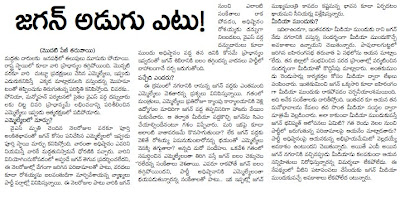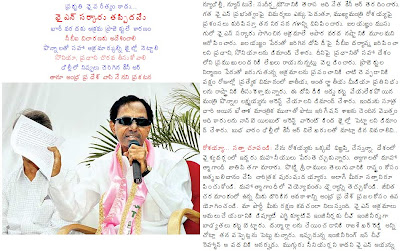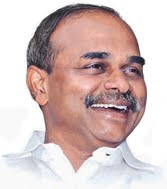
Thursday, October 29, 2009
Wednesday, October 28, 2009
Monday, October 26, 2009
Saturday, October 24, 2009
Will YS Jagan is contested from Pulivendula ....?

YS Jagan who failed in his bid to succeed his father as chief minister is now an angry man. Jagan had high hopes of becoming the CM with the blessing of Sonia
Jagan however had to return empty handed after meeting Sonia Gandhi. It is now clear that Sonia is not in a mood to entertain his claims for CM anytime in the near future.
Jagan has now decided to take a much more active part in state politics. Jagan is now considering the idea to quitting his Lok Sabha seat and contest for the Assembly from Pulivendula.
The above are some Telugu News Papers ( EENADU, AndhraJyothi )are negative propaganda on ... Mr Y.S. Jagan Mohan Reddy .
Friday, October 23, 2009
Thursday, October 22, 2009
Wednesday, October 21, 2009
Friday, October 16, 2009
Thursday, October 15, 2009
Wednesday, October 14, 2009
33 Congress MP's from Andhra..

Andhra Pradesh people are elected 33 Congress M.P but In UPA we do not have any importance. In the same way Congress High Command also negleting our leaders. Only Y.S.Rajashekar Reddy has good credit. None of them have credit except Jayapal Reddy.
Our leaders always waiting for HC, we donot have any rights to take individual decision.
It has proven in recent Andhra CM selection. They need a dummy CM, not like YSR.
Jagan’s Plan To Split Congress With Chiru

While it looks like the decision has almost been made at the Congress central command that it is going to be Rosaiah who would be heading the state as the chief minister until further notice, there seems to be a small current that is growing in the camp of Y S Jagan.
The talk in circles is that Jagan might soon be heading a new party and the interesting thing is, the Praja Rajyam Party is likely to be merging with this new YS congress if high command still delays. It is said that Chiranjeevi has been showing positive signs of merging PRP with Jagan led Congress.
On the other hand, Jagan is also said to be positive about welcoming Chiru if he wishes and the coming months will reveal what will the situation be like. Meanwhile, the political experts say that under the current position, this is the best move that Chiru can make before he gets humiliated further.
=====================================================================================
Congress president Sonia Gandhi is learnt to have given her nod for an early cabinet reshuffle during her meeting with CM K Rosaiah in the course of an aerial survey of the flood-hit areas on Monday.
Highly placed sources told that Sonia Gandhi discussed with the CM the steps needed to strengthen the government and governance in the state, which included giving the cabinet a new look. “Some heads are likely to roll. Some seniors along with some young MLAs will be given an opportunity,” a source told media.
Both Union home minister Chidamabaram and PCC chief D Srinivas are said to have stressed the need to revamp the cabinet at the earliest. While Chidambaram and Srinivas were also part of Sonia’s entourage during the aerial survey, Union law minister M Veerappa Moily — who is also AICC in-charge of AP — was not part of the chopper ride. He embarked only when Sonia headed for Karnataka after her aerial survey of Kurnool and Mahbubnagar districts.
It is reliably learnt that apart from the devastation caused by the unprecedented floods, Sonia expressed concern over the recent political developments in the party in the state. Sources said she wanted a strong and effective government in the state which could lead the party to victory in 2014 elections. Expressing confidence in Rosaiah’s leadership, she is said to have reassured the CM of full support from the party and the Union government.
Tuesday, October 13, 2009
Monday, October 12, 2009
Sunday, October 11, 2009
Saturday, October 10, 2009
Friday, October 9, 2009
Thursday, October 8, 2009
Wednesday, October 7, 2009
Tuesday, October 6, 2009
Monday, October 5, 2009
Sunday, October 4, 2009
Rosaiah Entering Samata Block......?
Friday, October 2, 2009
Thursday, October 1, 2009
YSR: The one man show in Andhra
A decade ago when Sharad Pawar was quitting the Congress over the Sonia Gandhi foreign origins issue, he told a group of journalists, "In the Congress party, there is no place for genuine mass leaders. There is only the high command and the loyal followers." That was 1999. Ten years later, it seems that Pawar was both right and wrong. He was right to the extent that in the Congress, the high command is ubiquitous and the Supreme Leader is unchallenged. He was wrong that the Congress could no longer throw up a regional satrap. Y.S.Rajashekhar Reddy was proof that it still possible to be a virtual one man show in state politics, and yet survive in the Congress.
When YSR became chief minister in 2004, he was fighting both history and geography. Congress chief ministers in Andhra had been practiced in the art of musical chairs. The previous Congress government in 1989 had seen three chief ministers in five years. The Congress government before that had seen four chief ministers in five years (a chaotic situation that eventually saw the rise of the idea of 'Andhra pride' in the guise of NT Rama Rao). Even the wily P.V.Narasimha Rao, who was able to stay as prime minister for a full five year term as head of a minority government could only last for fifteen months in Hyderabad in the 1970s. It was almost as if it was more difficult to manage the complex caste and regional factions in Andhra than it was to control politics at the Centre. More so in YSR's case because he came from the relatively backward region of Rayalseema, not seen as dominant in state politics.
And yet, YSR was able to prove the skeptics wrong, not only by lasting the full five year term, but even more remarkably by getting re-elected with an equally comprehensive mandate five years later. What made YSR succeed where others had failed? His critics - and there is no shortage of them - will tell you that his political style was more akin to Gujarat's Narendra Modi than to any traditional Congress state leader. He was ruthless (witness the manner in which he crushed all political opposition to him) and anti-democratic (notice how he jailed editors and sought to financially destroy those who spoke out against him). Unlike Modi though, there were serious charges of corruption which he was confronted with, charges that he seemed almost contemptuous of.
That YSR could get away with his authoritarian streak was because of his ability to build a firm rapport with the masses, a quality first detected during his hugely successful padyatra in 2003. A Chandrababu Naidu may have been feted by the pink papers, but he was eventually consumed by the euphoria of having been anointed the CEO of Cyberabad. YSR, on the other hand, was able to combine strong doses of populism with a delivery system that reached out to the Andhra countryside. Then, whether it was the success of his health insurance scheme, his irrigation projects, or the spread of NREGA, YSR was able to convince a majority of Andhraites that he would benefit them through direct cash transfers to the poor, even it meant bypassing the traditional elites of the state. In the process, he was able to overcome the caste and regional divides that had stunted governance in the past. The idea of a separate state of Telengana, for example, may have an emotional resonance, but what price statehood when you don't have cash in your bank account?
In that sense, YSR had the 'common man' touch, originally promoted by NT Rama Rao. NTR's two rupee rice scheme, for example, revolutionized the trajectory of Andhra politics, creating the basis of a pro-poor programme that has since been replicated in other states. YSR did not have NTR's charisma and star appeal. What he did have though was a certain down to earth welfarist approach to politics, where even as he and his family built a multi-crore empire, he did not forget that the foundation of his power was dependent on the support of the 'aam admi', that his electability would be ensured only if his schemes benefited the rural masses.
No surprises then that YSR was a great favourite of Sonia Gandhi, whose political philosophy is based on the core idea that the Congress's future lies with reaching out to India's poor. In fact, it would be no exaggeration to suggest that the UPA would not have been in power in 2004 and 2009 but for the remarkable success it achieved in Andhra. In the process, the central Congress leadership ended up virtually 'outsourcing' the party in Andhra Pradesh to YSR. While this might have bred resentment among an entire generation of Congress leaders in the state, it gave the workaholic 'Tiger of Cudappah' the space to carve out an identity for himself. Unlike several other Congress chief ministers who have felt routinely undermined by faction-fighting, YSR's success showed that it is possible for state leaders to flourish only when they are given the autonomy to operate without constant interference from the center.
The flip side though of creating a personality cult in a political party is that when the individual disappears from the scene, then the resultant vacuum is almost impossible to fill. That will be the big challenge confronting the Congress as it comes to terms with the loss of its strongest chief minister. Does the party revert to its time-tested formula of imposing a 'weak' leader on a state in the belief that such a chief minister will be acceptable to all factions? Or will it acknowledge that the YSR phenomenon demands a search for another tough, empowered state leader? In resolving its dilemma, we will know if YSR was indeed the last Congress regional satrap. Or a lasting symbol of a new model of governance.
--Rajdeep Sardesai IBNLive
When YSR became chief minister in 2004, he was fighting both history and geography. Congress chief ministers in Andhra had been practiced in the art of musical chairs. The previous Congress government in 1989 had seen three chief ministers in five years. The Congress government before that had seen four chief ministers in five years (a chaotic situation that eventually saw the rise of the idea of 'Andhra pride' in the guise of NT Rama Rao). Even the wily P.V.Narasimha Rao, who was able to stay as prime minister for a full five year term as head of a minority government could only last for fifteen months in Hyderabad in the 1970s. It was almost as if it was more difficult to manage the complex caste and regional factions in Andhra than it was to control politics at the Centre. More so in YSR's case because he came from the relatively backward region of Rayalseema, not seen as dominant in state politics.
And yet, YSR was able to prove the skeptics wrong, not only by lasting the full five year term, but even more remarkably by getting re-elected with an equally comprehensive mandate five years later. What made YSR succeed where others had failed? His critics - and there is no shortage of them - will tell you that his political style was more akin to Gujarat's Narendra Modi than to any traditional Congress state leader. He was ruthless (witness the manner in which he crushed all political opposition to him) and anti-democratic (notice how he jailed editors and sought to financially destroy those who spoke out against him). Unlike Modi though, there were serious charges of corruption which he was confronted with, charges that he seemed almost contemptuous of.
That YSR could get away with his authoritarian streak was because of his ability to build a firm rapport with the masses, a quality first detected during his hugely successful padyatra in 2003. A Chandrababu Naidu may have been feted by the pink papers, but he was eventually consumed by the euphoria of having been anointed the CEO of Cyberabad. YSR, on the other hand, was able to combine strong doses of populism with a delivery system that reached out to the Andhra countryside. Then, whether it was the success of his health insurance scheme, his irrigation projects, or the spread of NREGA, YSR was able to convince a majority of Andhraites that he would benefit them through direct cash transfers to the poor, even it meant bypassing the traditional elites of the state. In the process, he was able to overcome the caste and regional divides that had stunted governance in the past. The idea of a separate state of Telengana, for example, may have an emotional resonance, but what price statehood when you don't have cash in your bank account?
In that sense, YSR had the 'common man' touch, originally promoted by NT Rama Rao. NTR's two rupee rice scheme, for example, revolutionized the trajectory of Andhra politics, creating the basis of a pro-poor programme that has since been replicated in other states. YSR did not have NTR's charisma and star appeal. What he did have though was a certain down to earth welfarist approach to politics, where even as he and his family built a multi-crore empire, he did not forget that the foundation of his power was dependent on the support of the 'aam admi', that his electability would be ensured only if his schemes benefited the rural masses.
No surprises then that YSR was a great favourite of Sonia Gandhi, whose political philosophy is based on the core idea that the Congress's future lies with reaching out to India's poor. In fact, it would be no exaggeration to suggest that the UPA would not have been in power in 2004 and 2009 but for the remarkable success it achieved in Andhra. In the process, the central Congress leadership ended up virtually 'outsourcing' the party in Andhra Pradesh to YSR. While this might have bred resentment among an entire generation of Congress leaders in the state, it gave the workaholic 'Tiger of Cudappah' the space to carve out an identity for himself. Unlike several other Congress chief ministers who have felt routinely undermined by faction-fighting, YSR's success showed that it is possible for state leaders to flourish only when they are given the autonomy to operate without constant interference from the center.
The flip side though of creating a personality cult in a political party is that when the individual disappears from the scene, then the resultant vacuum is almost impossible to fill. That will be the big challenge confronting the Congress as it comes to terms with the loss of its strongest chief minister. Does the party revert to its time-tested formula of imposing a 'weak' leader on a state in the belief that such a chief minister will be acceptable to all factions? Or will it acknowledge that the YSR phenomenon demands a search for another tough, empowered state leader? In resolving its dilemma, we will know if YSR was indeed the last Congress regional satrap. Or a lasting symbol of a new model of governance.
--Rajdeep Sardesai IBNLive
Subscribe to:
Comments (Atom)

















































